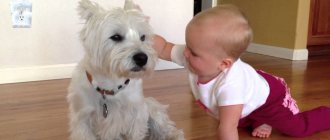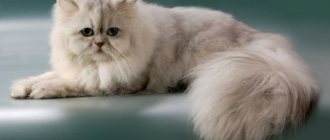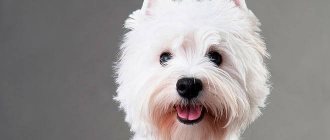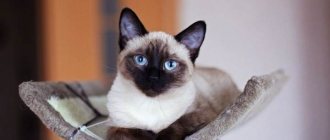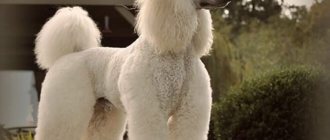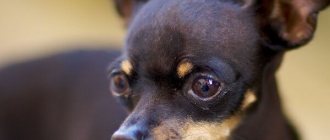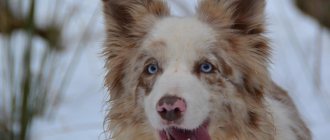The Highland Straight cat breed is a close relative of the Scottish Shorthair, only its representatives have a fluffy, silky coat. Thanks to their pretty appearance and friendly character, long-haired straight-eared Scots are becoming increasingly popular in Russia.
But before you decide to get a Highland Straight, you should find out whether this breed is easy to care for, what to feed it and how to behave with it.
Brief history of the breed
The history of the Scottish Straight cat began in 1961 in Scotland. At that time, the owner of a small farm discovered a fold-eared kitten in the litter of his pet. It was a cat who was named Susie.
She became the progenitor of the fold-eared and straight-eared long-haired Scottish. Breeders infused her descendants with the blood of Persian and British cats. As a result, 2 varieties appeared - Scottish Highland Straight and Scottish Highland Fold. The first has straight ears, and the second has folded ears. The breed was recognized in 1970.
Buying a kitten
The decision to purchase a Highland Straight kitten is an excellent choice for both a single person and a large family. Cats of this breed are ideal, almost problem-free companions. It can be difficult for a non-specialist to distinguish a truly purebred little Straight from just a fluffy baby, which is often taken advantage of by scammers.
Do not buy a kitten at the poultry market - you risk acquiring not only a mongrel, but also a sick animal. Trust your choice to one of the Highland Straight breeding nurseries - professional breeders value their reputation. Don’t choose your future pet based on a photograph, find an opportunity to go get it yourself, or even better, ask a breed specialist for help in choosing it.
Invite the breeder to show you not only the pre-selected kitten, but also its parents, brothers and sisters. The litter should contain both fold-eared and straight-eared babies - this is the first sign that you are acquiring a truly thoroughbred longhaired Scotsman.
The breed has a huge variety of colors
Criterias of choice
You should purchase a kitten at three months of age, no earlier - by this time the breeder will have already given the necessary vaccinations, and also determined the main breed qualities of the animal. Be prepared for the fact that a small show-class Highland Straight costs an order of magnitude more than a pet. The main selection criteria should be the health and behavior of the baby - pay attention to the following external factors:
- eyes - clear, not sour;
- ears - clean, not inflamed;
- the coat is shiny and well-groomed;
- the tummy is well-fed, but not bloated.
When meeting for the first time, the baby’s behavior can tell a lot - he should be cheerful, sociable and active, and not be afraid of a stranger. It is worth taking a closer look at the parents of your future pet - their appearance, character, living conditions.
Video: kittens who love to play
Interesting Facts
The long-haired straight-eared cat got its name from the mountainous terrain in Scotland, where the breed originated. The word highland translated from English means “highlands”.
Other interesting facts about Highland Straights:
- These cats have a poorly developed vestibular apparatus. When falling from a height, they do not always land on their feet. Scottish Longhairs are afraid when they are picked up and never climb to heights themselves.
- The Highland Straight gene for long hair was inherited from representatives of the Persian breed.
- Both straight-eared and fold-eared longhaired Scots are used to work with children with special needs. They are present in school classes in some European countries.
Mr. Cat recommends: character traits
Cats of this breed have an amazing, gentle and peaceful character in the cat family, even among domestic cats. They become very attached to a person, while most of their brothers still rather experience tender feelings for a specific place. They need manifestations of love and care, love affection and sitting on laps.
Many Highland Folds have one peculiarity: when they are interested or surprised by something, they sit down on their hind legs, reminiscent of a meerkat.
If there are children or other animals in the house, even those that naturally cause a hunting stance in the cat, you don’t have to worry: Highland Folds get along well with all representatives of the fauna, including dogs, rodents and birds. As a rule, they treat strangers without fear and wariness, they willingly go into their arms and allow themselves to be stroked. They generally like people's attention.
If people are busy, then the Highland Fold will not persistently pester, demand games or other forms of attention. They will perfectly find something to do on their own. At the same time, cats of this breed are very careful; as a rule, they do not pay attention to furniture, curtains and other interior items in order to sharpen their claws or otherwise damage them.
Kittens of this breed, like other kids, love to play and run, so the pet needs to prepare cat entertainment and toys in advance. They love to play with people, but you can safely leave them with children: they are absolutely not aggressive, they will not scratch or bite.
As cats mature, they become calmer, even sedate. If the owners are constantly at work, this does not cause any discomfort to the Highland Fold; he easily remains alone, but is very happy when people come. However, for this cat, schedule, order, and feeding at certain times are extremely important. She really doesn’t like the lack of orderliness, especially if there are interruptions in meals.
Breed description, standards, appearance
Scottish Highland Straights are well-built medium-sized cats with a dense build, a large head and a pretty face. Outwardly, they are very similar to their short-haired counterparts.
Dimensions and weight
The Highland Straight's body is proportional, muscular and fit. The height at the withers of an adult cat reaches 30 cm. The average weight of the animal is 4.5-6 kg. Females are slightly smaller than males.
Anatomical characteristics
Description of the Highland Straight breed according to the WCF standard:
- the head is round in shape, with a wide forehead, smoothly turning into the bridge of the nose;
- well-defined cheekbones and whiskers;
- the chin is neat, rounded;
- the eyes are large, round, expressive, the color of the iris depends on the color of the coat;
- Highland Straight ears are small, erect, with a wide base, rounded tips decorated with tassels;
- the nose is straight, without a hump, the nose is small;
- the body is well muscled, but quite flexible;
- The Highland Straight's paws are short, making the cat appear squat;
- the tail is thick, mobile, fluffy, its length reaches the shoulder blades.
Color and coat type
The Highland Straight's coat is long, but shorter than that of the Persian, silky and pleasant to the touch. With good care, it does not get tangled and looks smooth and shiny. In the chest area and on the back of the thighs the hairs are longer.
The standard allows any types of Highland Straight colors:
- solid – white, black, blue, cream;
- bicolor;
- tabby;
- smoky;
- chinchilla;
- shaded;
- tortoiseshell;
- van;
- calico.
Psychology
The Scottish Highland Straight has a good-natured and balanced character. These cats are very smart, neat and attached to their owner. They are peaceful and love being in the company of people, and they are also easy to train.
Highland Straights are peaceful and intelligent cats
Highland Straight kittens, like Maine Coons and British babies, are very playful, they can frolic for a long time both with the owner and with each other. Adults are characterized by independence; they themselves are not so persistent in drawing attention to themselves. Cats are calm, graceful and very charming.
Character and temperament
The character of Highland Straights is calm and peaceful, without a hint of aggression. Of all the family members, the cat chooses one person who becomes its object of adoration. She follows him everywhere and unobtrusively begs for a portion of affection. The pet does not like to sit in arms, but does not mind lying in the arms of its owner.
Highland Straights are patient with children and readily play with them. The main thing is that the baby does not offend the cat, otherwise she will avoid communicating with him. Longhaired Scots are not afraid of crowds. When guests arrive, the Highland Straight does not hide, but willingly gets to know everyone present. The only thing that can scare him off is a loud noise.
Highland Straight cats are very smart, so there are usually no problems with litter box and scratching post training. If desired, a long-haired Scottish Fold can be taught to perform simple tricks. Many representatives of this breed can fetch a ball in their teeth and jump over low obstacles on command.
Highland Straights get along well with other cats and dogs, especially if raised with them from an early age. However, the owner should try to pay the same amount of attention to all pets so that they have no reason to be jealous.
Scottish Straight Longhair cats are not very talkative. The pet's voice can be heard in rare cases, for example, when he is hungry. The rest of the time, the Highland Straight is usually silent. Another positive character trait is unobtrusiveness. If the owner is irritated or busy with something, the cat will never get in the way and demand attention.
Breeding Highland Straights
Highland straights are much easier to breed than folds, still due to the absence of the Fd mutant gene.
But before buying a cat, you need to take felinological courses and register the cattery with an organization or breed club . Only after this can you buy cats for breeding. Breed or show class cats are suitable. Highland straights ripen at 8–9 months. Both cats must participate in shows from the age of 10 months to receive breeding grades. Without them they will not be allowed to breed.
It is allowed to cross Highland Straights with British Shorthair, American Shorthair and British Longhair cats.
The first mating should take place no earlier than 1.5 years of age. Before breeding cats, you need to obtain a certificate from a club or organization. To do this, you need to provide pedigrees and breeding estimates for both cats. Without this, the litter will not be activated, and the kittens will not be considered purebred.
Highland pregnancy lasts from 60 to 65 days. Main signs of pregnancy:
- the cat is sick in the morning (she has toxicosis);
- nipples swell and turn pink;
- Appetite increases and eating preferences may change;
- character changes;
- The cat sleeps more and behaves a little apathetically.
Pregnancy becomes obvious to the naked eye only in the sixth week, but after 3 weeks it can be determined by a professional using ultrasound and palpation.
Pregnancy in Highland Straights lasts at least 2 months.
Kittens are examined by a specially appointed felinologist from a club or organization within 8 weeks after birth. Upon activation, a breeding certificate is issued for the entire litter and a metric for each kitten, which includes the name, breed, color and ancestors of the animal up to the 4th generation. If desired, the metric can be exchanged for a full pedigree.
There are certain rules in naming kittens: each new litter begins with one letter in alphabetical order (the alphabet is usually Latin, but Cyrillic is also possible). That is, the very first litter will have names starting with A, the second - with B, the third - with B or Latin C, and so on. In advance, even when registering the cattery, think about what you will call it: after all, after the kitten’s name the name of the cattery will always be written. It should not be too simple, but also not too pretentious. For example, a cattery with the name “Golden Cats” or “Favorites of the Sun” will look great, but “Cats” or “Man’s Best Friends” - not so much.
Before you start breeding cats, you need to register your cattery
How to choose the right kitten
The Highland Straight cat breed is not very common in Russia. And in order not to be deceived, it is better to buy a kitten from a nursery that specializes in breeding Scottish longhair cats. In this case, there is no doubt about the origin of the animal, since the owner of the nursery will provide a pedigree and a veterinary passport.
Kittens must be reserved in advance. The cost of an animal largely depends on the purity of the pedigree and compliance with the standard. Cats suitable for breeding are more expensive.
The average price for a Scottish Highland Straight kitten ranges from 10,000–50,000. Promising individuals without defects in appearance, who have every chance of becoming champions in the future, will cost the new owner 60,000–70,000 rubles.
When purchasing a Highland Straight kitten, you need to make sure that everything is okay with it. A healthy animal has clean ears and eyes, is active, sociable and has a good appetite. You should refrain from purchasing if your cat has dull, greasy fur, rapid breathing, or lethargy.
You should not remove a cat from a cattery before he is 12 weeks old. Until this time, the breeder must take care of him. His responsibilities include vaccination, training animals to use a tray and scratching post, as well as transferring kittens to special food after weaning.
In a litter of Scottish Longhair cats there are both straight-eared and fold-eared kittens. All babies are born with straight ears, which begin to droop at 3-6 weeks of age.
Kitten care
It is important to prepare in advance for the appearance of a Highland Straight in your home and buy everything you need for it:
- tray and filler;
- scratching post;
- bowls for food and water;
- comb;
- shampoo;
- air conditioner;
- products for daily care of ears and eyes;
- toys;
- harness (if you plan to walk).
In the first days of being in the house, the Highland Straight needs extra care. It is important not to frighten the cat, since for her moving to a new place and changing owner is a lot of stress.
The adaptation period for Scottish Longhairs lasts 3-5 days. At this time, you should not force the kitten to play; he needs to get used to the new environment, smells and sounds.
After moving into the house, you need to show the cat where her litter box is. It is better to take some used litter from the breeder in advance. He is placed in the cat's litter box. The pet will smell itself and begin to go to the right place.
Health
Scottish cats are physically strong animals.
They tolerate cold well and are resistant to infections.
However, these animals do not like heat.
To maintain a comfortable microclimate in the place where they live, you can use humidifiers.
Characteristic diseases
No specific diseases have been found in cats of Scottish breeds.
Vaccinations
The first vaccination is given to a kitten at the age of 7-9 weeks.
In accordance with the instructions for the drug, revaccination is carried out after 2-3 weeks.
Kittens are vaccinated annually. In the second year, vaccination will need to be done after 11 months.
Vaccination is carried out only on healthy animals.
Deworming is carried out 14 days beforehand.
If the animal shows signs of illness - cough, poor appetite, vomiting and any other disturbances - the vaccination is canceled.
The vaccine will only make the condition worse. First you need to treat the cat, and only then vaccinate it.
If the animal has been ill 3-4 months before the procedure, only inactivated vaccines should be used.
The use of specialized medications will prevent relapse of the disease.
Important! Vaccination should be carried out by a veterinarian. He will be able to select the correct dosage and administer the drug.
And one more reminder - the better the conditions in which the cat is kept, the less likely it is that it will get sick.
Care and maintenance
Both a small apartment and a spacious private house are suitable for keeping the Highland Straight breed. Scottish longhair cats are not very active, so they can easily do without walking. Caring for them is not burdensome, but there are still some nuances.
Straight-eared Highland Straights are quite clean. They spend most of their time licking themselves. This is where the main danger lies - the cat swallows the fur, and this can lead to intestinal blockage. For this reason, the pet owner should pay attention to caring for the fluffy coat.
Hygiene procedures
The cat's eyes are wiped every day, otherwise brownish crusts accumulate in the corners. To treat the eyelids, you can use hygienic lotion or warm boiled water and cotton pads.
Caring for your cat also includes cleaning its ears. Although Highland Straights have erect ones, sulfur still accumulates inside. Its excess is removed with a clean sponge soaked in lotion 3 times a month. It is necessary to trim the Highland Straight's claws at approximately the same frequency.
Grooming
Twice a week you need to comb the coat with a massage brush. During molting, the procedure is carried out daily. Highland Straights do not like to bathe, so they are washed no more than 3-4 times a year. This is usually done before visiting the exhibition.
During bathing, use shampoo for long-haired cats and conditioner, which prevents the formation of tangles and adds shine to the fur coat.
Tray
Highland straights are demanding about the cleanliness of the tray. It needs to be cleaned morning and evening. If the litter is dirty, the cat will not want to go inside. Once a week, it is advisable to empty the entire contents of the tray and wash the bottom and walls with hot water, but without using chemicals.
Colors
In addition to the silky structure of its thick and long coat, the Highland Fold has a stunningly wide palette of colors. Conventionally, they are divided into the following groups:
- Plain. All existing options are marble, black, chocolate, blue, lilac and red. The color is solid, without marks, spots or stripes.
- Smoky. In this case, the undercoat is colored entirely light, and the tips of the guard hairs are black.
- Bicolor. The Highland Fold of this color has a variety of combinations of strictly two colors in the form of spots and markings.
- Colorpoint. The breed standard allows for acromelanism in Highland Folds. In this case, the body is painted in a light color, and the protruding parts of the body: muzzle, legs, tail, and sometimes ears are dark.
- Tabby. In this case, the cat will look like a tiger or leopard, only in a more fluffy and touching version. Any combination of colors, the main thing is a clearly readable letter “M” on the forehead.
- Tortoiseshell. Basic colors are black and red in a bizarre combination.
- Calico. Considered one of the rare ones: the lower part of the Highland Fold's body is painted white, and the upper part has different shaped spots of black and red.
Feeding the cat
The health and life expectancy of the Highland Straight largely depends on the quality of nutrition. The cat's diet should contain enough vitamins, microelements and protein, which contributes to the formation of muscle mass.
Complete diet
Breeders recommend feeding Highland Straights with ready-made premium or super-premium dry formulas. Industrial feeds are properly balanced and contain meat, grains, vegetables and vitamin supplements. However, some cat owners prefer to create their own diet from natural products.
In this case, you need to include in the Highland Straight menu:
- lean meats - rabbit, turkey, veal, chicken;
- offal – heart, chicken gizzards, liver (once a week);
- sea fish;
- cereals – rice, oatmeal;
- vegetables and herbs;
- low-fat cottage cheese, yogurt, kefir;
- eggs.
The cat should not be fed pork, lard, or potatoes. Salty, spicy foods, sweets, bread and processed foods, as well as bones are strictly prohibited.
Feeding frequency
Adult cats are fed 2 times a day - morning and evening. At lunchtime, you can treat the Highland Straight to a piece of cheese or other delicacy. It is very important that clean drinking water is always available.
Kittens eat more often because their metabolic processes proceed faster. Babies up to 3 months are fed 5-6 times a day. Next, the pets are transferred to a four-time diet. From 6 to 9 months, food is distributed 3 times a day.
Vitamins and minerals
When feeding Highland Straights with natural food, the risk of developing vitamin deficiency increases. After all, it is impossible for a non-specialist to create a diet so that the cat receives all the necessary substances in the right quantity.
For this reason, veterinarians recommend feeding Scottish longhair cats with vitamin and mineral preparations 2 times a year.
Diseases
Highland Fold cats live about 15 years. If crossing over several generations was carried out according to all the rules - i.e. If you don’t breed two Highland Folds, the offspring will be in good health. But it often happened (and still happens) that owners, not knowing the rules or not wanting to follow them, got a pair of a cat and a cat, and then received offspring with serious mutations and, accordingly, health problems.
The first problem is polyarthritis. In most cases, it affects pets who are overfed, have weakened immune systems, and are elderly. The cat becomes less active, tries to move little and stops playing and jumping; after sleep, the joints become painful and hot to the touch.
Treatment is medicinal: anti-inflammatory non-steroidal drugs, painkillers. Sometimes surgery is required.
The second problem is osteochondrodysplasia. Alas, this disease cannot be cured: you can only make your pet’s life easier. It concerns cartilage: it is due to this mutation that we observe folded ears. But often the problem gets worse: cartilage in other parts of the body is damaged. Signs of the disease: deformation of the limbs, crooked teeth, slow growth, lameness and other changes in gait, shortening of the hind legs, ulcers on the paws. Treatment: supportive care and steroid (anti-inflammatory drugs), manual therapy, massage, and in some cases surgery.
If your Highland Fold is lazy and inactive, it may develop other musculoskeletal problems over time.
Highland Folds are also prone to some other diseases: diabetes, gastritis, heart disease. The owner needs to carefully select the menu and vitamin supplements, take the animal for walks, carry out deworming on time and give the pet all basic vaccinations (against rabies, panleukopenia, rhinotracheitis, etc.).
Education and physical activity
You need to start raising a Highland Straight from an early age. The owner should not allow the cat to cross the established boundaries. When training your pet, you should remember its delicate and sensitive nature.
The Scots are very gentle and vulnerable, you cannot shout at them, and even more so it is forbidden to beat an animal. Rough handling of the Highland Straight will not achieve the desired effect, but rather will lead to a loss of trust on the part of the cat. It is better to be patient and reward your pet for good behavior.
Nutrition
Most cats of this breed are not prone to obesity and do not overeat. You can feed your Scotsman both ready-made food and natural food; only human food from the table is not suitable for a cat. Your pet must be accustomed to a certain diet right away, from childhood.
Feeding your pet with industrial food is the best solution for working, very busy people. Manufacturers of premium food take into account the various characteristics of cats, including age, so each pet can be given suitable nutrition, taking into account its individuality. The main thing is that the food is of high quality, from a reputable brand. They include not only the nutrients the animal needs, properly balanced, but also vitamins, minerals and other compounds. That is, they provide a complete diet, and the owner does not have any worries.
If the owners have opted for natural food, they will have to prepare food for their pet separately. The diet of an adult animal should mainly consist of protein foods, since cats are carnivores, their gastrointestinal tract is adapted to digesting soft fibers of meat.
The basis of nutrition should be lean meat and poultry. Meat by-products, porridge, and vegetables are also allowed; cottage cheese, fermented baked milk, and yogurt are required.
There is no need to give milk: after the kitten reaches the age of breastfeeding, it does not produce enough enzymes to digest whole food. It is sometimes possible to pamper your cat with fish, especially if she loves it, but this is often not recommended. In cats with a fish diet, the risk of developing urolithiasis and cholelithiasis greatly increases.
Health and susceptibility to disease
In general, the Scottish Highland Straight cat is in good health. However, this breed is prone to diseases of the musculoskeletal system. The most common are hip dysplasia and osteochondrodysplasia.
These diseases are manifested by deformation of bones and cartilage tissue. Highland straights are also susceptible to skin diseases - allergies, dermatitis. Healthy cats with good care can live about 18 years.
Interaction with household members
While adults understand and accept the vulnerable nature of the Scottish cat, children do not always measure their strength in playing with the cat. Therefore, it is not advisable to leave this breed alone with children. After all, anyone can offend a cat, but not everyone can then run away from it.
Otherwise, Highlands are patient and reserved. They generously accept other pets into their hearts and onto their sofa, preferring to politely ignore such neighbors.
Among adult household members, the cat prefers to choose a “favorite” owner with whom he spends his free time. It is unlikely that you will be able to cuddle such a pet, but enjoying his company is very pleasant.
Vaccinations and antiparasitic treatment
Not a single domestic cat is immune from infection with infectious diseases, and the Highland Straight is no exception. Some of them can be deadly, including:
- chlamydia;
- calcivirosis;
- rabies;
- panleukopenia, or plague.
Cats are vaccinated against these diseases when they reach three months of age. At this time, the kittens are still in the nursery, so vaccination is carried out by the breeder. Next, you need to vaccinate Highland Straights annually.
Twice a year it is recommended to carry out preventive treatment of the animal against fleas and worms.
Highland fold mating
When thinking about breeding Highland Folds, you should know that only following certain mating rules will help you get healthy offspring with excellent breed characteristics. The first and most important of them is that you cannot cross two lop-eared partners. The offspring of such parents will appear with serious pathologies. The ideal partners for highland folds are the “Scots” straights.
The second important point is that you should not breed a female if she is not yet one and a half years old. It is at this age that the cat is ready to bear kittens and give birth. Ideally, the first mating should occur during the pet’s third estrus.
The cat is brought for a “date” to the cat, usually on the second day of estrus. Both partners must be treated for parasites and vaccinated in advance. It is better to select an experienced male, especially if this is the female’s first mating. It is desirable that the cat be larger than the female cat, as well as the same or similar color. For a guaranteed result, the female must stay with the male for at least two days.
Pros and cons of the breed
The Scottish Longhair Highland Straight cat deserves the attention of potential owners, because it has many more advantages than disadvantages:
| pros | Minuses |
| Beautiful appearance | Long wool |
| High intelligence, good learning ability | Tendency to joint and bone diseases |
| Friendly, calm character | Great cost |
| Cleanliness | |
| Tolerance for children | |
| Ability to get along with other animals |
Highland Straight cats are ideal for families with children and older people. They are not too active, obedient, smart and clean, so they do not create many problems for their owners.
Such a pet will be able to brighten up the life of a lonely person and join a large family, becoming a true friend for a child. However, those who are forced to often leave home should not get a Highland Straight. After all, representatives of this breed become very attached to their owner and constantly need his attention.
Wool is the pride of the breed
Due to their close relationship with the Scottish, longhaired Scottish cats closely mimic the appearance of their less furry relatives. The only difference between the breeds is the length and quality of the coat.
Highland Straights got their fur from the Persians, which automatically deserves admiration, because Persian wool takes pride of place in popularity among cat fur coats.
In addition to its elegant appearance, wool has many other advantages:
- The fur does not have the habit of getting into tangles, so owners do not have to comb the cats too often;
- Another plus is cleanliness. The coat is long, but the cat is easy to care for, so you won’t have to bathe your pet often;
- The molt is going more or less tolerably. A cat sheds less hair than a Persian. And with regular brushing, its amount can be reduced to a minimum.
Crossbreeding experiments gave the breed a whole range of different colors and shades. There are several popular colors: black, white, tabby, merle, harlequin, two-tone and smoke.
